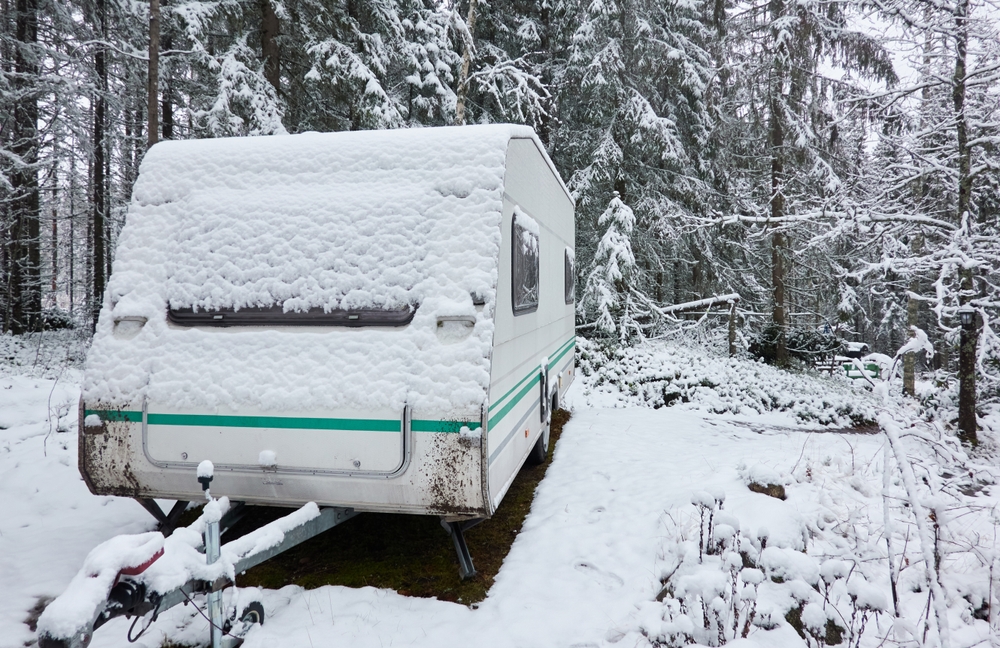The cooler nights and shorter days mean one thing: summer has officially ended and the travel season is over.
It also means that proper storage of your recreational vehicle (RV) for the winter months should be top on your to-do list.
While you might think proper winter storage for your RV is as easy as finding a space in your driveway or yard, in reality, it involves a lot of planning and attention to the finer details.
To make sure your RV is ready for the next camping season, here are quick tips to prepare your mobile home for the colder months ahead.
What is RV winter storage?
RV winter storage refers to the practice of storing recreational vehicles (RVs), including — but not limited to —motorhomes, travel trailers, and camper vans, during the winter months when they are not in use.
This is done to protect the RV from the harsh winter weather, including freezing temperatures, snow, ice, and road salt, which can cause damage to the vehicle and its components.
There are various options for RV winter storage, including:
- Outdoor storage: This is the most basic and affordable option for RV storage, but it offers the least protection. While opting to store your RV outdoors during the winter might save you money compared to renting a storage unit, it also exposes your vehicle to numerous risks. If not managed carefully, this choice could result in significant, long-term damage to your RV, making it advisable to consider alternative storage options.
- Covered storage: Covered storage provides some protection from the elements by sheltering the RV from rain and snow. This option can be a good compromise between cost and protection.
- Indoor storage: Indoor storage facilities, such as warehouses or specially designed RV storage buildings, offer the highest level of protection. RVs are stored inside, protecting them from all weather conditions. However, indoor storage is typically more expensive.
If you’re an RV owner looking for a secured and convenient place to park during the winter months, Spacer got you covered.
Spacer lets you instantly see all available parking spots near you, compare prices, and choose the one that suits your needs, saving you hundreds of dollars each month compared to traditional parking options.
Our locations cover major cities, including San Francisco, Chicago, New York, Washington DC, and Boston, all while keeping your budget in check.
What factors should you consider when preparing your RV for winter storage?
Storing an RV is an important consideration for RV owners, and the decision between renting storage space or keeping it on your property depends on several factors. Here are some key points to consider when deciding on your RV storage options:
- Cost: Renting an RV storage space can incur additional expenses, such as monthly rental fees. Notably, the cost of storage can vary widely depending on the location, the size of the RV, and the amenities provided (like climate control). Storing it on your property may save you money, but there could be other storage costs like creating a dedicated space or maintaining it.
- Security: RV storage facilities, which are typically commercially operated, often have security measures in place. This includes surveillance cameras, gated access, and on-site staff. Storing your RV at home may require you to invest in additional security features like locks, alarms, or fencing to protect your investment.
- Space and zoning regulations: Another factor to consider when deciding how to store your RV is the available space on your property and local zoning regulations. Some states have restrictions on storing large vehicles on residential properties, so check with your local authorities. In some areas, you may need to create a suitable storage area or even get a permit.
- Climate and weather: While some RV owners overlook this factor, climate in your area plays a significant role in your decision. If you live in an area with harsher winters, it may be wise to opt for indoor or climate-controlled storage to protect your RV from extreme temperatures, snow, and ice. On the other hand, mild climates might make outdoor storage more feasible. Generally, areas in the southern and western parts of the U.S. experience milder winters and may have a shorter winter storage period.
- Maintenance: Whether you choose to store your RV outside or in a covered space, any savvy RV owner knows regular maintenance is essential. This includes cleaning, inspecting for damage, and winterizing if necessary. Climate-controlled storage can help reduce the wear and tear caused by temperature fluctuations.
- Access: Another factor to take into account is how often you plan to use your RV. If you store it at home, you have easy access whenever you want. Renting storage space may be less convenient in terms of access, but it offers security and protection.
- Insurance: Check with your insurance provider to ensure your RV is adequately covered based on your chosen storage method. Some insurance policies may require certain security features for at-home storage.
Why should you properly store your RV for winter?
Properly storing your RV for winter is essential for several reasons. Firstly, RVs are substantial investments, and taking the time to store them correctly helps extend their lifespan.
Cruise America estimates that the lifespan of an RV can range from 10 to 30 years or 100,000 to 300,000 miles, with factors like the type of RV, owner habits, and maintenance influencing it.
By safeguarding your RV from winter’s wear and tear, you’ll significantly reduce the need for extensive maintenance and repairs when the travel season revs up again in the spring.
This means you’ll not only save money but also ensure that your RV is ready to hit the road in top shape without any unexpected hiccups.
10 tips for storing your RV in winter
1. Choose the right winter RV storage location
One of the top considerations when preparing for winter RV storage is to find the right place to store it.
As we’ve mentioned, if you’re choosing to store your RV in your driveway or yard, make sure to do your due diligence and look up city or county codes. You should also check if your homeowner association (HOA) regulations will allow the storage of an RV in your private property for an extended period.
Once you get an all clear from local authorities, store your RV in a location that will not expose it to harsh weather conditions that come with the colder months, including wind, rain and snow. Sun exposure should also be taken into consideration when choosing a location.
When choosing a parking spot for your RV, it’s important to avoid parking under trees. This not only helps keep your RV clean from sap and debris but also reduces the risk of damage from falling tree limbs.
Given these, the most ideal setup for long-term RV storage is a covered garage that is completely enclosed on all sides, equipped with a spacious access door. It should also have security features (like cameras and regulated access), and preferably temperature-controlled.
If indoor RV storage is unavailable, opt for an outdoor storage location with shelter from the elements. Make sure the chosen location has proper drainage to prevent water accumulation around your RV.
2. Clean the interior
When preparing your RV for storage, it’s highly recommended to channel your inner Marie Kondo. To get the interior ready for long-term storage, begin with a thorough decluttering process.
To prevent issues like mold and pests, empty the refrigerator and cupboards of any food or perishable items.
Conduct a thorough vacuuming, dispose of the trash, and take out any personal items that don’t need to remain in the RV during its long-term storage. Keep an eye out for any moisture-prone areas and address them before putting your RV in storage.
Even though you won’t be using linens or dishes during the winter, cleaning and organizing these items now will expedite your return to the road when the weather becomes more favorable.
Additionally, this not only prevents pests like rodents from infiltrating your RV but also ensures that your mobile home is ready for camping trips in spring.
Next, roll up your sleeves for a deep clean inside your RV. Cover all the nooks and crannies, from the living area to the bathroom and kitchen. Get those cabinets, fridge, freezer, shelves, tabletops, and appliances sparkling clean using a combination of disinfectants and all-purpose cleaners.
Make sure your interiors are well-ventilated by leaving the doors of your cabinets, fridge and freezer slightly open when you’re done cleaning.
If your RV has slide-outs, make sure the floors are spotless to allow for easy retraction when it’s time to close them for winter storage.
During the winter storage period, when you may need to keep various items inside your RV, you can use the RV’s tables for storage. Simply place some boxes or camping supplies on top of the table, making it easy to locate them when needed.
3. Protect your RV from pests
When you tuck your RV away for the winter, chances are you won’t be paying it many visits until you’re ready to prep for the next camping season. However, during this period, it’s essential to recognize that other critters might find their way inside if you’re not well-prepared for RV storage.
Make your RV critter-resistant by placing mouse traps in and around your rig. Rodents tend to be attracted to the RV’s auxiliary electrical power cable and often enter through openings where the cord passes through the wall.
To prevent this, unplug the cord, disconnect it from the RV, and ensure the cable hatch is securely closed. Your RV dealer or service provider can also conduct an inspection of the RV’s underside, addressing any holes or cracks by sealing them.
Additionally, consider preventive measures for ants, especially as they tend to be more active during the warmer months (usually at the start of spring season).
4. Invest in a high-quality RV cover
If you decide to store your RV outside, it’s recommended to invest in a cover made especially for an RV.
The cover will protect against extended exposure to ultraviolet rays that can damage your RV’s paint job. Aside from shielding your RV from UV damage, it will also protect your vehicle from wind damage, tree sap and bird droppings.
While it feels like the simple solution, using a plastic tarp as an RV cover for winter storage isn’t a great idea. Tarps tend to flap around in the wind and might end up causing damage to the RV’s exterior.
Instead, it’s better to invest in a cover that’s made specifically for your RV and tailored to your local climate. These covers come with a set of straps to securely wrap up your RV. What’s more, they also feature handy zippered openings, allowing you access to your RV when needed.
5. Inspect and prep the exterior
Taking care of your RV’s exterior is a smart way to ensure it weathers natural wear and tear, so that all its parts are good to go when spring rolls around.
Examine sidewalls, roof, windows, doors, seams, and access panels to identify and address any cracks and holes that may require attention.
Or, if you prefer, you can have a service center perform a comprehensive RV inspection and handle the sealing of any cracks or holes. It’s important to note that using the wrong sealant may lead to improper sealing, potentially leaving your RV vulnerable to water damage.
In this situation, it might be more practical to enlist the expertise of a trained professional to reseal your RV, which can be coupled with draining the water system if needed.
6. Protect your RV’s tires
As you go about inspecting your RV’s exterior, While you’re giving your RV’s exterior the once-over, don’t forget to include a thorough tire inspection in your checklist to ensure there are no punctures or holes.
Once you’ve confirmed that your tires are in good condition, be sure to remove any dirt and debris that may have accumulated on your tires.
It’s also crucial to find a suitable cover to provide effective protection from the winter elements. Prolonged exposure to freezing temperatures and harsh UV rays can lead to tire damage, and sometimes small critters may take refuge in your tires during the colder months.
Consult your tire’s instruction manual for the recommended maximum cold pressure and inflate your tires accordingly before applying the cover.
Another option to consider is investing in RV skirting, which not only safeguards your tires but also provides added insulation and protection for the entire underside of your RV, enhancing its overall winter readiness.
For an extra layer of protection, wherever you choose to park your RV during the winter, think about placing plywood blocks under each tire to elevate them off the ground.
Additionally, be sure to set tire chocks to keep the wheels from rolling, and don’t forget to use tire covers to shield them from potential UV damage.
If your RV has undercarriage storage, it’s essential to thoroughly empty and clean it to prevent the growth of bacteria and mold, which can lead to unpleasant odors and potential tire damage.
7. Beef up your security measures
Don’t forget to secure your RV during the winter storage period. Implement security measures such as wheel locks, hitch locks, and alarm systems.
Ensure that all doors and windows are tightly closed and locked to prevent unauthorized access.
8. Keep your RV’s engine and mechanical systems in shape
To prepare your RV’s engine and mechanical systems for winter storage, focus on preventing freezing, corrosion, and cold-related damage. Here’s how you can ensure their protection:
Ensure your fuel tank is full before placing your RV into storage. This helps prevent moisture from forming in the fuel system. Using a fuel stabilizer can provide additional protection.
Follow your RV manufacturer’s recommendations for using fuel stabilizers and antifreeze to safeguard these critical components.
Consider changing your oil and filter before storing your RV. Leaving old oil in your tank for an extended period can lead to the accumulation of corrosive acids.
Taking these precautions will help keep your RV’s engine and mechanical systems in good shape during the winter months.
9. Battery care
Proper battery maintenance is crucial during winter RV storage, as cold temperatures can significantly reduce battery life.
To extend your battery’s lifespan, disconnect it, remove it from the RV, and store it in a dry and cool place. Alternatively, use a battery maintainer or trickle charger to keep it in good condition.
10. Regular inspection
Periodically check on your RV throughout the winter storage period. Look for any signs of damage or issues that may need immediate attention.
Regular inspections can help you identify and address problems before they become major headaches
Lastly, think ahead to spring. Plan your RV’s revival by creating a checklist of tasks to complete before hitting the road again.
This proactive approach ensures you’re ready for your next adventure without delays.
To learn more about how to keep your vehicle in tip top shape during the colder months, make sure to check our article on Parking in Colder Climates: How to Best Protect your Vehicle from Snow.




